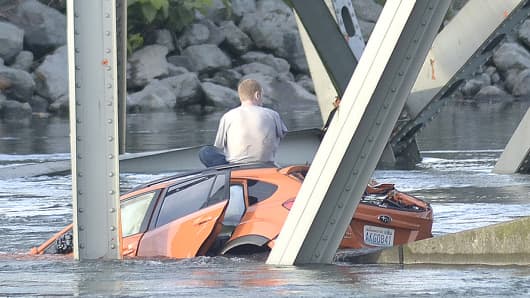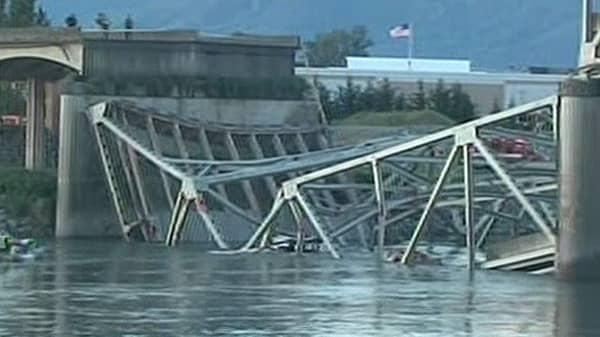The spectacular scene unfolded about 7 p.m. Thursday on the north section of the four-lane Interstate 5 bridge near Mount Vernon, about 60 miles north of Seattle and 40 miles south of the Canada border, and disrupted travel in both directions. Officials warned it could be weeks before things returned to normal.
The Washington State Patrol said the truck driver works for Mullen Trucking in Alberta. The tractor-trailer was hauling a housing for drilling equipment Vancouver, Wash., when the top right front corner of the load struck several trusses on the north end of the bridge, the patrol said.
(Related: America's Crumbling Bridges)
The driver, William Scott, of Spruce Grove, Alberta, near Edmonton, voluntarily gave a blood sample for an alcohol test and was not arrested. A top company official said Scott was amazed by what he saw happen.
"He's a little bit bewildered," Ed Scherbinski, vice president of Mullen Trucking, said in an interview with The Associated Press. "He looks in the (rear-view) mirror and the bridge is coming down behind him."
Initially, it wasn't clear if the bridge just gave way on its own. But at an overnight news conference, Washington State Patrol Chief John Batiste blamed it on the too-tall load. The vertical clearance from the roadway to the beam is 14.6 feet.
The truck made it off the bridge and the driver remained at the scene and cooperated with investigators. Two other vehicles went into the water about 25 feet below as the structure crumbled. Three people were rescued and were recovering Friday.
The trucking company said it received a state-issued permit to carry its oversized load across the bridge. Scherbinski said the Washington state Department of Transportation had approved of the company's plan to drive the equipment along Interstate 5 to Vancouver, Wash.
He also said the company hired a local escort to help navigate the route. He said the driver was well-experienced with handling oversized loads.
"This is what we do for a living. We pride ourselves in doing things the proper way,"
Mike Allende, a state DOT spokesman, confirmed the truck had its permit.
"We're still trying to figure out why it hit the bridge," he said. "It's ultimately up to the trucking company to figure out whether it can get through. It's their responsibility to make sure the load they have can travel on that route."
Cynthia Scott, of Spruce Grove, Alberta, said she spoke with her husband moments after he saw the bridge fall into a river in his rear-view mirror. She said there was a small ding in one of the front corners of the load.
Dave Chesson, a state DOT spokesman, said there were no signs leading up to the bridge warning about its clearance height.
The National Transportation Safety Board was sending an investigative team.
Dan Sligh and his wife were in their pickup on Interstate 5 heading to a camping trip when a bridge before them disappeared in a "big puff of dust."
"I hit the brakes and we went off," Sligh told reporters from a hospital, adding he "saw the water approaching ... you hold on as tight as you can."
Sligh and his wife were taken to Skagit Valley Hospital with non-life-threatening injuries. The other man was reported in stable condition at United General Hospital in Sedro-Woolley, hospital CEO Greg Reed said.
The bridge was inspected twice last year and repairs were made, Transportation Secretary Lynn Peterson said.
"It's an older bridge that needs a lot of work just like a good number of bridges around the state," she said.
The bridge was not classified as structurally deficient, but a Federal Highway Administration database listed it as being "functionally obsolete"—a category meaning that the design is outdated, such as having narrow shoulders and low clearance underneath.
The bridge was 1,112 feet long and 180 feet wide, with two lanes in each direction, Brady said. There are four spans, or sections, over the water supported by piers. The span on the north side is the one that collapsed. It's a steel truss bridge, meaning it has a boxy steel frame.
The mishap was reminiscent of the August 2007 collapse of an I-35W bridge in Minneapolis that killed 13 people and injured another 145 when it buckled and fell into the Mississippi River during rush-hour.
Sligh was thankful.
"You're kind of pinching yourself and realize you're lucky to be alive."
_ By The Associated Press With CNBC.com





